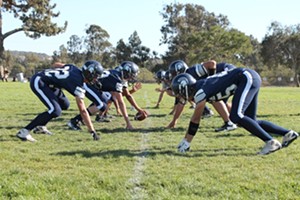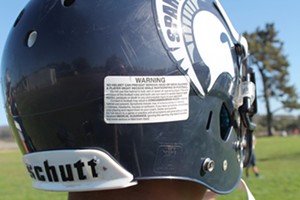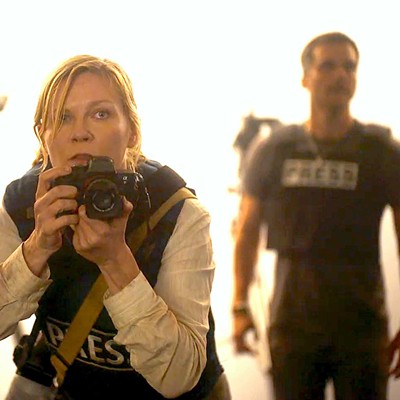
Before the start of every football season and the clash of helmets ensue, Orcutt Academy football coach Tony Payne makes all of his players read the warning label on their helmets: “No helmet can prevent serious head or neck injuries a player might receive while participating in football. … Contact in football may result in concussion-brain injury which no helmet can prevent.”
Payne, a former football player, said head injuries were treated much differently in his day, when a concussion simply meant a player had his “bell rung” and returned to play without a second thought.
“It was ignorant at the time,” Payne said. “What’s going on now is safer.”
According to the Center for Disease Control and Prevention (CDC), the last decade has seen a 60 percent increase in emergency room visits among adolescents and children for sports-related concussions.
Increased fatalities, severe brain damage, and concern for player safety have led to more protective measures in youth sports. On the Central Coast, eight local high schools now utilize a computer-based program to ensure the safe return of athletes to play.
Since 2009, San Luis Sports Therapy has partnered with Mission Prep, Paso Robles, Templeton, Morro Bay, San Luis Obispo, Nipomo, and Arroyo Grande high schools to bring the ImPACT Concussion Testing program to athletics. Orcutt Academy was added to the list of schools this year.
Stacey Ritter, San Luis Sports Therapy’s director of sports medicine and athletic training, said ImPACT is a neuro-cognitive test that measures cognitive memory skill.
“Before season, athletes take the test and provide a baseline score,” Ritter said. “If they sustain a concussion, they take the test again to compare the results.”
In order to return to play, athletes must score in their normal response range. Slower response times can help indicate the severity of the concussion. Ritter emphasized that the ImPACT program is not used as a diagnostic tool.
“We normally rely on the student athlete to tell us what’s going on,” she said. “This is one of the few objective tools we have; we can actually see what’s happening with brain activity.”
She said protocol for concussion treatment has changed in the last five years; previously the cognitive component to this injury was not realized. State law now mandates much of concussion management.
According to the CDC, beginning in 2009, Washington became the first state to pass a concussion-in-sports law known as the Zackery Lystedt Law 4. This law was inspired by a tragic injury to high school football player Zackery Lystedt, who sustained a concussion. Before his first injury could heal properly, Lystedt received another blow to the head. This resulted in a rare condition called Second-Impact Syndrome.
When someone has Second-Impact Syndrome, Ritter said, “the brain swells irreversibly and the athlete is permanently disabled or they do not survive.”
One month later in 2009, Max’s Law 5 passed in Oregon. The CDC reported that between 2009 and 2012, 43 states passed laws for preventing concussions in sports.
Ritter said the quality of research has helped medical and athletic professionals better understand the harmful effects of concussions.
This type of injury has a more detrimental impact on the developing adolescent brain, and affects not only physical performance but academic performance as well.
“The youth brain is in a highly developmental state; a concussion causes a neurochemical cascade disruption to development,” Ritter said. She also emphasized the long-term effects of concussive injuries.
“If an athlete under 18 sustains a concussion, they are four to six times more likely to sustain another,” Ritter said. “If an athlete sustains three to four concussions, they are more likely to suffer from depression later in life.”
More severe detriments include the above-mentioned Second-Impact Syndrome, and multiple sub-concussions—little blows over time—can trigger a condition called Chronic Traumatic Encephalopathy. While symptoms of this condition are not usually prevalent until the age of 40, Ritter said there is no telling who will suffer from it. It’s the same condition that plagues many former NFL players.

For Ritter and the sports medicine team at San Luis Sports Therapy, conservative management and education are the key components to protecting players from concussions.
“Concussions are an invisible injury and symptoms are very individual,” Ritter said. “The biggest challenge is recognizing the injury.”
Because of this, and a tremendous concern for athlete safety, San Luis Sports Therapy donates half the cost of treatment to provide each of its eight partner schools with an athletic trainer who has been extensively educated on recognizing the symptoms of a concussion.
Brennon King joined the athletic training team at Orcutt Academy at the beginning of the school year. King said if a player is exhibiting signs of a head injury, he performs a sideline assessment to begin logging symptoms. If the player has suffered a concussion, he takes the ImPACT test again in two to three days.
“The test has them play with shapes, numbers, and recall,” King said. “It also asks players historical questions to determine factors that could affect the test.”
The athletic trainer added that he will be using the ImPACT program with all contact-sport athletes.
King and Ritter said it’s crucial to treat a concussion conservatively; players don’t return to play until they can meet their baseline score. Athletes not only need rest from physical activity, but cognitive activity as well.
“On average, it can take up to three weeks to heal,” Ritter said. “We are treating all conservatively and completely.”
Educating the public, parents, and athletes on concussion signs, symptoms, and reporting is a crucial factor in protecting players. Ritter said they have also made an effort to educate local referees who act as another set of eyes on the field.
A recent law passed in January 2013 requires youth coaches to take a course on concussion injuries. Coaches are also taking their own precautions with players.
“We go over the warning labels on their helmets step by step,” Payne said. “We are also emphasizing that the kids tackle with their chest and shoulders rather than their helmets.”
The ImPACT test surprised Gage Flick, a junior at Orcutt Academy.
“The test was weird; there was a lot of flashing, but I could see how it would be useful.”
Sophomore teammate Dylan Miller said he thinks the program is important because it will help players return to the game as quickly and safely as possible.
“It’s important to be honest,” Miller said. “You don’t want to end up hurt in the future.”
Down the road, Ritter hopes to have an athletic trainer at each of the high schools.
“With the number of kids playing youth sports, it’s a necessity [that] we take this more seriously and treat it more conservatively,” she said.
Staff Writer Kristina Sewell keeps her head up when making tackles. Contact her at [email protected].









